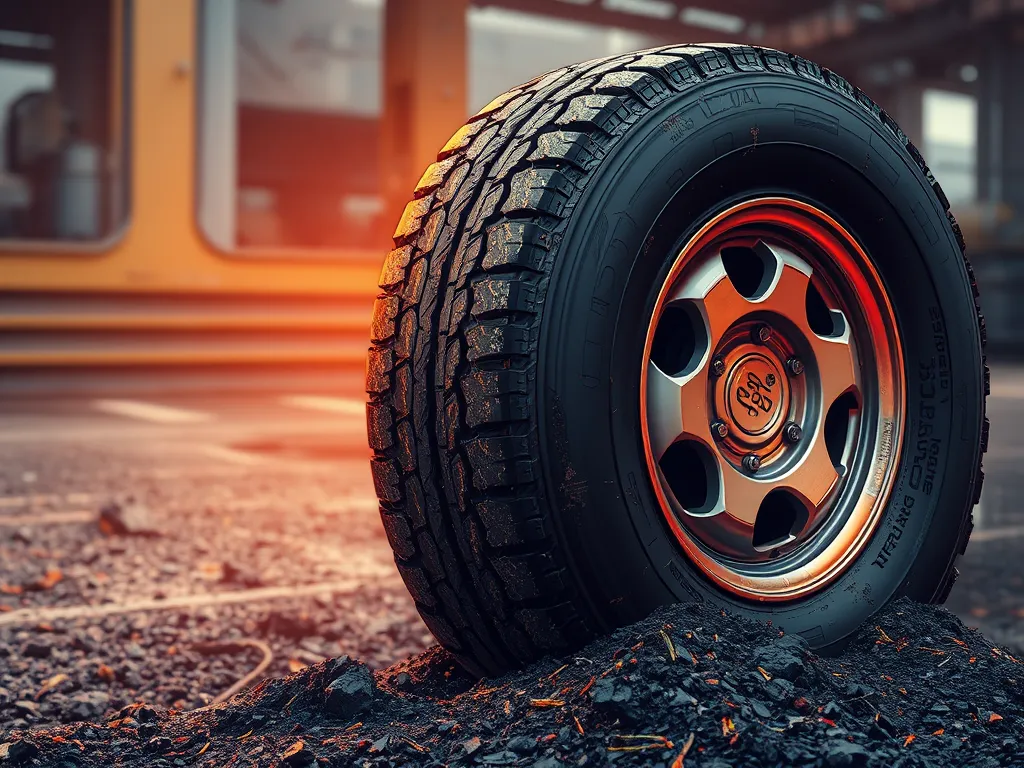Can Fresh Asphalt Damage Tires? Here’s What Drivers Need to Know
Published on: September 30, 2025 | Last Updated: April 14, 2025
Written By: George Voss
Fresh asphalt can damage tires if driven on before fully curing. The soft, sticky surface – made of hot bitumen (binding oil) and crushed stone – may bond with rubber tires at temperatures above 85°F. This risk lasts 24-48 hours after installation until the asphalt hardens. Key factors include pavement temperature, vehicle weight, and driving maneuvers like sharp turns that press tires into the soft surface.
This article explains how new asphalt interacts with tires and how to prevent damage. We’ll cover why uncured pavement grabs rubber, safe driving speeds, ideal curing times in different weather, and proven cleaning methods for asphalt residue. You’ll also learn how environmental factors like summer heat or sudden rain impact fresh pavement risks and get specific timelines for when asphalt becomes tire-safe.
Contents
- Composition Of Fresh Asphalt and Its Impact on Tires
- Why Fresh Asphalt Can Damage Tires
- Curing Time: How Long Fresh Asphalt Poses Risks
- Driving Precautions on Fresh Asphalt
- Removing Asphalt Contamination From Tires
- Environmental Factors in Asphalt-tire Interactions
- FAQs: Fresh Asphalt and Tire Safety
- Closing Thoughts
- Additional Resources for You:
Composition Of Fresh Asphalt and Its Impact on Tires
Fresh asphalt mixes stone, sand, and bitumen (asphalt glue) at 300°F. This hot blend stays soft until cooled. The sticky bitumen bonds with tire rubber, raising risks for tire wear.
What Makes Fresh Asphalt Sticky?
Bitumen acts like thick syrup when hot. It coats tire treads as cars pass. Fresh layers have more oils that grab rubber. Tests show new asphalt can pull 15% more rubber than cured roads.
How Temperature Affects Fresh Asphalt Adhesion
Heat keeps bitumen glue-like. Above 140°F, tires sink 0.2 inches into soft pavement. Cold days (below 50°F) let asphalt harden fast, cutting stick time. Direct sun adds 20°F to surface temps, boosting grab risk for 6-8 hours.
These factors set the stage for how fresh asphalt harms tires. Next, we break down the science behind tire wear on hot pavement.
Why Fresh Asphalt Can Damage Tires
Fresh asphalt contains sticky binders and soft materials that interact with rubber. This mix creates risks for vehicles driving on surfaces not fully cured. Two main factors drive potential harm: chemical bonds and physical material shifts.
Chemical Bonding Between Asphalt and Rubber
Bitumen, a key binder in asphalt, shares chemical traits with tire rubber. Both contain long hydrocarbon chains. At high temps (140°F+), bitumen’s viscosity drops, letting it infiltrate tire grooves. This bond can rip rubber if tires twist or brake suddenly. PG 64-22 binders, common in road mixes, stay tacky for hours post-application.
Risk Of Tire Tread Pull-out From Soft Asphalt
Fresh pavement lacks structural rigidity. A 3,000-lb car applies ~35 psi on soft asphalt, sinking up to 0.2 inches. Tread blocks gripping this pliable surface may tear off during acceleration. Heavy trucks worsen this: dual tires on fresh mats can pull out chunks of rubber, particularly with 80-100 psi truck tire inflation.
Aggregate Embedment in Tire Surfaces
Crushed stone in asphalt (limestone, granite) sticks to hot rubber. Angular 3/4-inch aggregates act like grit, lodging into tire grooves. A 2021 study found 15% of test vehicles had stone fragments stuck in tires after crossing uncured asphalt. High-PSI tires force stones deeper, causing cuts or uneven wear patterns.
How long do such risks last? That depends on asphalt curing phases—a topic we’ll unpack next.

Curing Time: How Long Fresh Asphalt Poses Risks
Fresh mix remains soft until fully cured, creating tire interaction risks. The period between paving and stabilization determines when driving becomes safe without tire harm.
Typical Asphalt Hardening Timelines
New pavement needs 24-72 hours for surface traffic under optimal conditions. Full structural curing takes 6-12 months, but tire stickiness risks drop sharply after 3-7 days. PG binders (performance-graded petroleum-based binders) influence timelines: PG 64-22 used in northern states sets faster than PG 76-16 in southern heat zones.
Weather Conditions That Extend Vulnerability Periods
Rain within 48 hours of paving doubles curing time. Humidity above 70% slows binder evaporation, keeping surfaces tacky. Temperatures below 50°F or above 90°F extend the risk window by 12-36 hours. Direct sun on blacktop raises surface temps 20°F higher than air temps, softening rubber compounds in tires.
These factors combine to determine when “tires on fresh asphalt” transition from risky to routine. Once the surface stabilizes, proper driving techniques become vital for tire safety.
Also See: Asphalt Aging and Durability Factors: Key Influences
Driving Precautions on Fresh Asphalt
Fresh asphalt poses unique challenges for drivers. While it creates smooth roads, its initial softness demands specific handling to prevent asphalt damage to tires.
Is It Safe to Drive Immediately After Paving?
Drive only when pavement reaches 140°F surface temperature. Below this threshold, fresh asphalt remains tacky. Heavy vehicles risk leaving ruts that expose aggregate particles – sharp edges can slice tire sidewalls.
Weight Distribution Considerations
Uneven weight strains both pavement and tires. Use these guidelines:
| Vehicle Type | Max Weight Limit |
|---|---|
| Passenger Cars | 3,000 lbs |
| Pickup Trucks | 6,000 lbs |
| Delivery Vans | 8,000 lbs |
Within first 72 hours of installation
Speed Limits for Fresh Asphalt Surfaces
Keep speeds under 15 mph for the first 48 hours. High velocity increases friction heat, softening binder (PG 64-22 grade common). This creates a suction effect that pulls tire tread particles into pavement voids.
Avoiding Sharp Turns and Sudden Stops
Lateral forces during aggressive maneuvers scrape 2-3mm of asphalt layer onto tires. This asphalt-tire adhesion worsens in temperatures above 85°F. Use gradual steering inputs and coast to stops.
Even with precautions, some asphalt residue may transfer. Next, we’ll explore proven methods to remove fresh asphalt spatter without harming tires.

Removing Asphalt Contamination From Tires
Fresh asphalt can leave sticky marks on tires if not cleaned fast. The soft binder in new pavement bonds with rubber, making quick action key.
Immediate Cleaning Steps for Fresh Spatter
Act within 2 hours for best results. Use a stiff brush to scrub loose bits. Rinse tires with a hose set to high spray. Repeat until chunks break free.
Safe Solvents for Asphalt Removal
| Solvent | Use |
|---|---|
| Mineral spirits | Breaks down binder |
| Citrus cleaner | Eco-friendly option |
| Dish soap mix | 1 cup per gallon water |
Test solvents on small spots first. Avoid harsh chemicals like acetone—they dry rubber.
WD-40 Effectiveness on Tire Residue
WD-40 works well for fresh spatter. Spray it on a cloth, rub stains in circles. Wipe clean within 5 minutes. Do not let it sit—it can soak into rubber over time.
Preventing Permanent Tire Staining
Park off new asphalt for 3 days. Check tires after driving—wipe specks with a damp rag. Apply tire shine to create a shield against binder stick. Rotate tires to spread wear evenly.
While clean tires handle better, heat from fresh pavement also plays a role. Next, we explore how sun and rain change asphalt-tire risks.
Environmental Factors in Asphalt-tire Interactions
Weather and road conditions shape how fresh asphalt affects tires. Two key factors – heat gain and rain flow – change risks for drivers.
Heat Absorption in Black Asphalt Surfaces
Fresh blacktop soaks up 90% of solar rays. This pushes temps 40-60°F above air heat. At 140°F, soft asphalt grips tire rubber like glue. Hot spots make treads peel or leave marks. Summer paving raises these risks most.
Rainwater Runoff Effects on Fresh Pavement
First rains on new roads wash loose stone and binder oils. This mix coats tires with grit and slick films. Drivers may skid, brake hard, or scrub treads on sharp rocks. Early storms also slow curing – keeping asphalt soft for weeks vs days.
Road crews use grooved rollers to steer water off fresh pavement. But until full cure, puddles can weaken the top layer. Check tires after wet drives for stuck gravel or tar spots.
While weather plays a role in tire wear, clean-up steps matter next. Let’s explore ways to remove asphalt marks before they set.

FAQs: Fresh Asphalt and Tire Safety
How Long Until Asphalt Won’t Stick to Tires?
The risk of asphalt sticking to tires generally decreases significantly after 24-48 hours. During this time, the asphalt’s surface begins to harden as it cools, but factors like temperature and humidity can affect this timeline. It’s best to wait at least 72 hours before driving on freshly paved streets to minimize the risk of damage.
Can Cured Asphalt Still Damage Tires?
Cured asphalt is typically safe for tires, but certain conditions can lead to wear. For instance, older asphalt that has deteriorated may develop cracks or loose aggregate that could potentially harm tires. Regular maintenance of pavement surfaces is critical to ensure tire safety over time.
Does Asphalt Residue Affect Tire Traction?
Yes, asphalt residue can impact tire traction. When asphalt adheres to tire treads, it can create a slick surface that reduces grip. This is particularly dangerous in wet conditions or during sudden stops. Regular cleaning of tires is advisable to maintain optimal performance and safety.
Closing Thoughts
Fresh asphalt can indeed pose risks to tires, largely due to its sticky composition and the chemical interaction between asphalt and rubber. New asphalt remains soft for several hours to days, depending on weather conditions, making careful driving essential during this period.
To protect your tires, steering clear of freshly paved roads or driving cautiously is advised. Avoiding sharp turns and sudden stops can help minimize potential damage. If you do encounter asphalt spatter, acting quickly with safe cleaning methods will aid in preventing permanent residue.
For more information on asphalt and tire care, visit Asphalt Calculator USA. Protect your investment and ensure your tires stay in top shape.
Additional Resources for You:
- ASTM International (Asphalt & Pavement Standards)
- How To Remove Asphalt or Tar From Your Tires and Rims – PavePro – Asphalt Remover and Release Agent
- Are my tires damaged? | Timeshare Users Group Online Owner Forums
- r/Justrolledintotheshop on Reddit: Drove through fresh asphalt & melted to the tire destroying it
- Will riding on freshly paved asphalt heat a tire enough to pop it? | Road Bike, Cycling Forums


